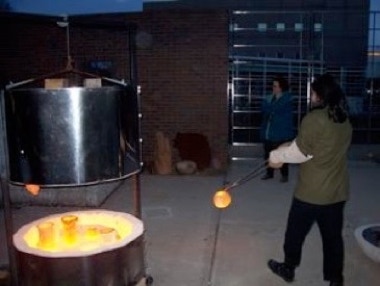Raku : A special way of firing
Raku Glazing and Firing
Apply the glaze to a bisque pot the day before firing or force-dry pots so that the pot is dry. If you do it the same day of firing, force-dry the glazed bisque piece in an empty kiln to drive the moisture out of it. Attempting to fire a pot with moisture in it will cause it to explode.
When I fire, I like to use a thermo-couple for accurate temperature, but if you don’t have one, look through the peep-hole with dark glasses on, I let the kiln get hot enough for the glazes to have a wet, watery appearance. shut off the burners, pull the pot out of the kiln and head for the wood chip pile. This is approximately 1400-1800º F depending on your glaze formula.
Turn off the burners and remove the organge-yellow hot pots from the kiln using long handled tongs and protective leather gloves (see photo above). For effect, and away from other people, I sometimes wave the pot back and forth like a pendulum to promote some crazing in the glaze(spider-web cracks) . You then thrust the pot into wood chips or other combustion able material such as leaves, pine needles, horse manure, etc. making sure that the all the surfaces of the pot are touched by the combustion able material. All is covered by a metal tub and allowed to smolder for an hour or so. This starves the wood chips of oxygen and promotes the fantastic iridescent metallic colors associated with raku glazes.. You leave it in the smoldering wood chips, under the metal tub for about a half-hour or so. Where no glaze covers the ceramic surface, the smoky atmosphere turns that portion black.
At this point remove the pot from the wood chips, and if you are in a hurry, either dunk it in water, or spray it with water. Otherwise, let it cool and eventually scrub it clean in a sink with the rough fiber side of a kitchen sponge or steel wool, and when completely dry (either over night, or force dry it), coat it with a diluted solution of water and Future brand floor wax. Clear, neutral paste wax works well too. This gives the pot a soft sheen, while bringing out the blacks in the surface. The fracturing action of the glaze, when penetrated by smoke leaves a spider-web of dark thin lines which is striking. Areas of white bisque clay that is left unglazed tends to turn completely black from the carbon, that is produced by the burning chips. It makes a nice dry black, a contrast to the shiny glazed surfaces. Darker clays don’t work particularly well with this process unless the piece is covered by a layer of white slip. .
Return to Top of Page





